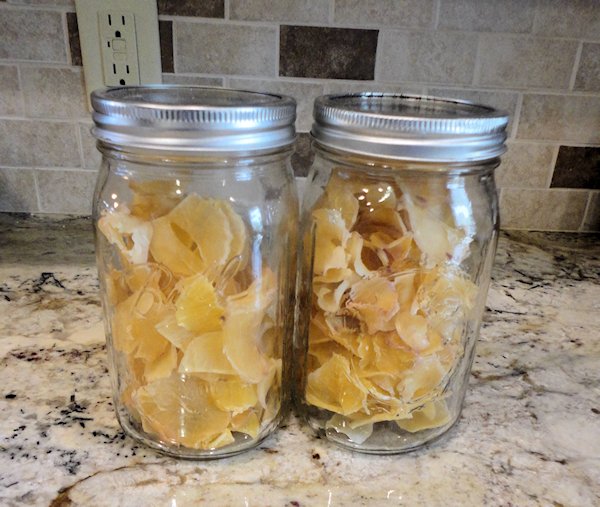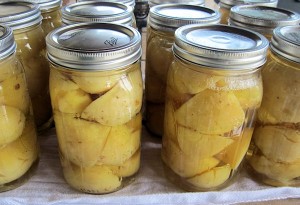It’s always so exciting to plant the seeds and new seedlings in the garden. I never seem to know when to stop planting. As long as there’s space inside the fenced area, I’m planting something. My favorite potatoes to eat and grow are Yukon Gold and in our area, they’re fairly expensive and the ones I can buy are no comparison to home grown potatoes.
Last year, I planted over 200 seed potatoes and I think every one of them came up and produced a lot of potatoes. I thought I would never get finished putting up potatoes. Most of those were dehydrated. In this post, I wrote about rehydrating them.
The previous year, most of the potatoes were canned so except for the dehydrated hash browns, I was mostly using the canned potatoes . . first in/first out, you know!
Most of the potatoes that I planted this year have now been dug up but there are probably 25 plants still growing that came up volunteer from potatoes left in the ground last year. They got a bit of a later start so they’re not ready yet, which is nice because I’ll put up all the potatoes that I dug and we may have fresh potatoes still in the garden til frost, since the volunteers just continue to come up.
After taking an inventory of the dehydrated potatoes from last year, I decided to go ahead and can this year’s potatoes. We probably have more dehydrated potatoes than we will eat before next year’s crop is ready to be put up. 200 plants produced a whole lot of potatoes and I used my better judgment and planted only about 50 plants this year.
These had just come out of the canner and some of the lids had not “popped” yet but they did all seal. Yay! Today I will can the remaining potatoes and we will end up with about 40 quarts of potatoes. If those volunteer plants in the garden go wild, I may end up having to can some of them, but my plan is to eat them as they’re ready and not have to can any more potatoes this year.
Canning potatoes is pretty simple.
- Scrape the skins. If the potatoes are really fresh, I use a short paring knife and scrape the skins. I think the potatoes hold together better if they have not been peeled, but that may be just my thinking. Any bad spots are removed at this time.
- Very small potatoes can be left whole. Medium potatoes should be cut into quarters and large potatoes should be cut into 6 or 8 pieces. I don’t cut mine up too small as they tend to fall apart during canning if they’re too small.
- While preparing the rest of the potatoes, to keep the potatoes from turning brown, those that are already done are placed in an ascorbic acid solution. I use 1 tsp. Fruit Fresh to 1 gallon water.
- Remove from the ascorbic acid solution, and place in boiling water for about 8 minutes.
- Drain and pack them into sterilized, hot jars. I add not quite 1 tsp. of salt per quart jar.
- Fill the jars with boiling water. Do no use the same water used to boil the potatoes . . use fresh boiling water.
- Leave about 3/4″ head space.
- Using standard canning procedures (sterilizing the lids, wiping the rims, etc.).
- Process pints for 35 minutes and quarts for 40 minutes at 10 pounds pressure.
Pretty simple . . and you’ll be enjoying “fresh” potatoes all year!



jennifer says
no tattler lids? I had heard of them around and about, but never ordered any until you had “advertised” their sale last December, and I ordered a whole bunch of them, but have not used them yet. I’ve never canned potatoes- we just store ours until it’s time to plant again, and that works pretty well. (I do buy new seed potatoes every other year- you can only re-plant one year, then it’s best to start fresh with certified potatoes seeds.) we plant a ton of potatoes (selling most of them, obviously!) but I would like to try canning them sometime. it’s just at that time of year I’m too busy/tired, and it’s so much easier to just put them downstairs in the cellar… but it would sure be nice to have a head start on dinner some days! (especially if I’ve spent too much time in the sewing room some winter day!) BTW- I’m loving Tell it to the Stars! still have to do my june block, but I have a few days yet!
JudyL says
I use and love Tattler lids but these were new jars so I just used the lids that came with them. If I had a cellar or basement for storing my root crops, I’d definitely go that route.
Jen says
I’d be interested on a post how you dehydrated hashbrowns. I have seen a few different ways online. Like you, we love Yukon gold. We waited too long this year to buy our seed potatoes and had to order online…so I bought a few different varieties.
JudyL says
Click on the link (text is colored where I mention dehydrating and that’s a clickable link) to a detailed post that I did last year.
Celia says
Do you have to use salt in each jar? Have you ever done it without salt? Thanks
JudyL says
You do not have to use salt but it’s real hard to get the taste right if there’s NO salt at all. The recipes say to put up to 1 tsp. per quart but I usually use about 1/2 tsp. per quart.
Diana says
The tattler lids are great .. I have used them and love it ..
They are made not far from where I live and I know the guy who does them for Tattler .. Great product at least in my mind !